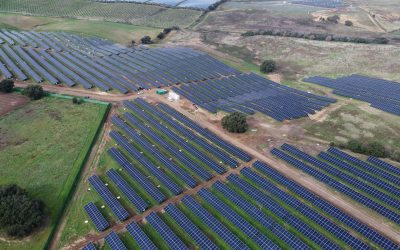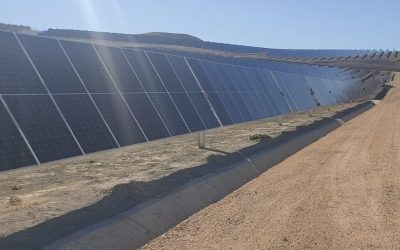Peter Karam, COO of BNZ, discusses the potential of agrovoltaics in his article published in PV Magazine.
Agriculture and animal husbandry emerged 10,000 years ago at a revolutionary moment in history. Now, in a new context of technological revolution, agriculture and animal husbandry can once again play a key role in accelerating humanity’s progress towards environmental sustainability. We are not talking about reinventing farming or animal husbandry processes and systems, but about how their intelligent and efficient use can help catapult renewable energies around the world.
Vaclav Smil, scientist and analyst expert in human development and energy, already related these concepts a few years ago when he noted in his reflection ‘Science, energy, ethics, and civilization’: “Human societies have always been limited by the rates at which they have been able to harness solar radiation and its terrestrial transformations. Food and fuel production was limited by the inherent low efficiencies of photosynthesis, as well as by the inadequate supply of plant nutrients. As a result, average crop yields remained low for millennia, leading to recurrent famine and chronic malnutrition.
This phrase helps us to understand the history of civilisation and our future, especially in the face of a total change in the way we understand natural resources and the future of the planet. It seems that, now that we are all aware of the need to commit to renewable energies, the time has come to go one step further. And one of the main renewables is photovoltaic solar energy, a clean source of energy, but one that has some misunderstandings due to its high surface occupation. This is evidenced, for example, by the emergence of conservationist movements opposed to this clean energy.
In this context, the phenomenon of agrovoltaics has emerged, which seeks maximum synergy between photovoltaic energy and agriculture through the installation of solar panels on agricultural land, or more recently, agriculture on photovoltaic land. This alternative is positioned as one of the benchmarks for making a key sector in the fight against climate change more sustainable, while offering the possibility of achieving additional uses and profitability for assets such as the land where the projects are located, beyond the generation of solar energy itself.
If we go back to the beginnings of this trend in Southern Europe, in 2013 we started to see some pioneers who combined the use of the land to install photovoltaic panels and also destine the land for its original use: the proliferation of fauna and flora. At that time, no one was talking about the agrovoltaic concept, which has gradually become more and more present in all projects.
The aim of sharing space is to optimise land use and generate benefits such as the preservation of biodiversity, the coexistence of agricultural and livestock activities in areas where photovoltaic plants have been built, and the improvement of agricultural productivity. In this sense, something very relevant to point out is that at the beginning of agovoltaics there were no regulations establishing this type of good practice, but rather it was the energy producers themselves who decided to combine these two activities, both to reduce carbon emissions into the atmosphere and to benefit local agriculture and livestock farming.
At the administrative level, initially some requirements had to be fulfilled, but not at the level of environmental sustainability in a broad sense, but only at the landscape level: for example, with the installation of vegetation screens to hide the panels. When the environmental compliance activities started, it was proactive, as the obligation to implement local benefits linked to the production of solar energy arrived around 2019 in most Southern European countries with the aim of aligning all actors.
In the beginning, the conversation was simply between producers and farmers or shepherds in the area. For example, an agreement was reached between the two parties to allow sheep to graze peacefully on the solar project site. The PV plant benefited from having chemical-free grass at ground level thanks to the sheep acting as natural weeding and with the satisfaction of having helped a local shepherd, with no objective of public approval. However, this phenomenon has now evolved into specific designs of photovoltaic plants adapted to any type of such farming activities. This is demonstrated by the fact that more than 2.8GW of agrovoltaics were installed worldwide in 2020, according to a report published by the Fraunhofer Institute.
Today, the evolution of this environmental involvement also takes into account beekeeping, the cultivation of vines to produce wine, the planting of lavender, rosemary and other aromatic and medicinal plants, as well as the planting of olive trees, always taking into account the characteristics of the land and the climate of each territory. All of this is what we value at BNZ in each new project, in order to adapt as much as possible to the needs of the local community and its environment.
At the moment, in addition to having some local guidelines on how to support the territory, the majority of independent energy producers want to comply with the ESG guidelines set by the United Nations. This means a generalisation of this type of good practices that are a must for any type of project that BNZ carries out in Spain, Italy and Portugal.
Although any company seeks profitability, the commitment of most companies in the sector is also to offer a social benefit, and agrovoltaics is essential in this respect. And even more so considering that, According to data from the Ministry for Ecological Transformation and the Demographic Challenge of the Government of Spain, Approximately 50% of the land is classified as usable agricultural land. This represents more than 23 million hectares. Therefore, this is a future opportunity for the development of this concept in Spain and other areas of Southern Europe, achieving a balance between the generation of solar energy and the development of the primary sector.
In addition, according a study published by Nature, if approximately 1% of the available land were dedicated to producing solar energy, it would be possible to compensate for the world’s energy demand. However, on Spanish territory, according to studies carried out by the University of Almeria, by simply placing photovoltaic panels on the roofs of the more than 40,000 hectares of greenhouses in south-eastern Spain, up to a third of the energy consumed in Spain could be produced.
However, there are also challenges for the efficiency of agrovoltaics, such as the fact that it takes up more space than a standard solar plant. Added to this is the opportunity that still exists for bifacial solar PV technology, with improved efficiencies due to greater distances between modules. At the moment, fixed support systems are used to raise solar panels 3.5 to 5 metres above the crop field, allowing agricultural machinery to access the crops below. It is particularly relevant in hot areas, where shade can protect crops by reducing temperatures and preventing excessive evaporation. It also helps to protect the crop from hail and heavy rain. It is estimated that this reduces the need for irrigation by 20%.
There are numerous examples, most of them developed in the Netherlands and Germany focusing on wheat, potatoes, celery, blueberries, cranberries, redcurrants, raspberries, strawberries and blackberries. In these locations, it has been shown that, during hot days, the conditions in the conreos under the panels were two to five degrees Celsius cooler than in traditional cultivation methods. There are also clear examples of their usefulness with olive trees in Sicily, peach trees and vines in France, and artichokes and peppers in Murcia.
In Spain, one of the great examples is in Talayuela Solar, one of the largest solar parks in Europe, developed by the company Solarcentury in Cáceres. There, they have launched a programme for the recovery of the wild rabbit and various conservation measures for reptiles, cranes, carracas and owls. In addition, they have promised to plant 5,000 acorns per year to multiply the number of holm oaks, the creation of ponds and floating islands to favour the nesting of ducks and other species, together with a pasture for 500 sheep, among other promises.
There are also other success stories in Italy, such as EF Solare Italia, the largest Italian PV operator, which operates agrovoltaic plants in Umbria, Sardinia and the Calabria region. In the latter, panels with a total capacity of 18MWp have been installed on the roofs of greenhouses growing 11,000 citrus plants, including a popular local variety of lemon. Agrovoltaic projects are also being developed in Italy in collaboration with the animal husbandry industry. The Caseificio Buon Pastore dairy farm near the city of Ravenna in the Emilia Romagna region has a solar plant where flocks of sheep graze freely. At the same time, the panels prevent the grass from growing too much, which would reduce the amount of light the panels receive.
In another southern European country, Portugal, the cereal production and forestry company Quinta da Cholda has begun installing solar photovoltaic panels that allow it to be self-sufficient in terms of energy, and on land where they are planting rows of indigenous plants suitable for human consumption and flowers to support biodiversity and feed bees and other pollinators.
These are just a few of the most vociferous examples, but there are hundreds of others we could talk about how they improve the quality of the land’s flora and fauna while adding clean energy to our planet. We just need to have the appropriate regulatory adjustments to encourage the installation of agrovoltaics without the need for land use change, which would be the real boom in solar energy.


